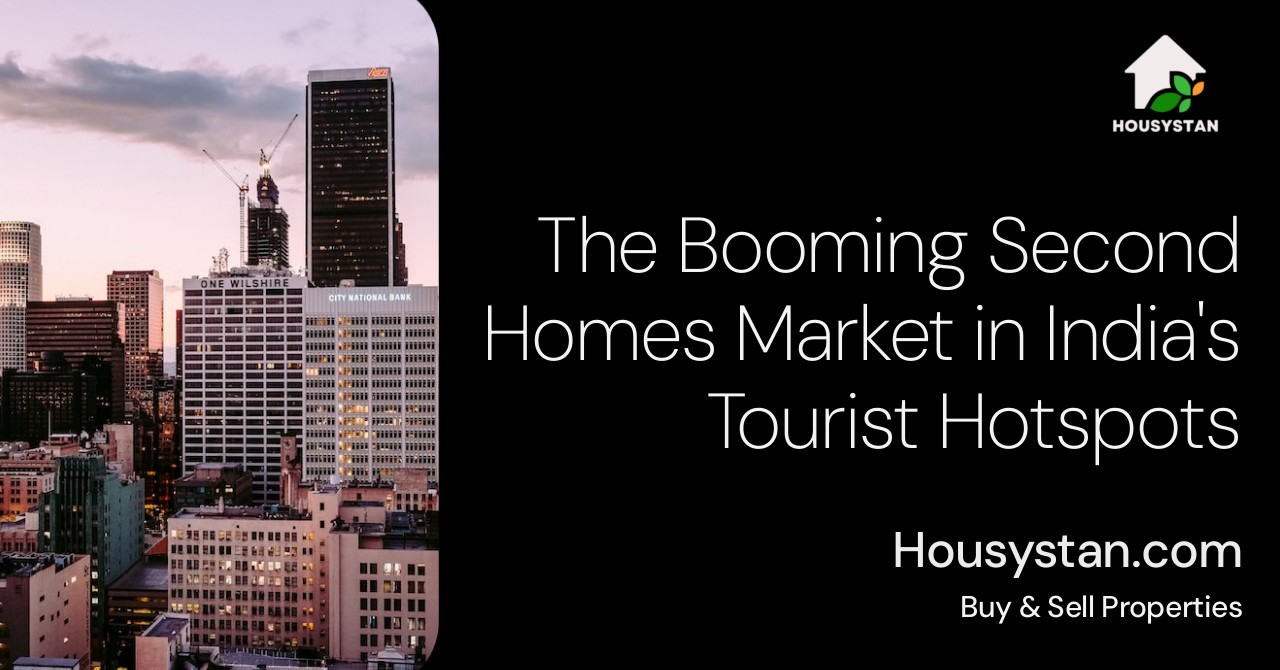The Booming Second Homes Market in India's Tourist Hotspots
Read latest blogs and articles from Housystan

The Information mentioned here was last updated on:
31/12/2025The Booming Second Homes Market in India's Tourist Hotspots
India's real estate market is witnessing a fascinating trend, as more people are investing in second homes in the country's most popular tourist destinations. From scenic hill stations to sun-soaked beaches, these areas are becoming hotspots not just for visitors, but also for property owners. This growing interest can be attributed to several factors, including the rise of remote work, the desire for a secure investment, and the allure of owning a home in a desirable vacation locale.
What Drives the Demand for Second Homes?
- Verified Tenants/Buyers
- Unlimited Property Listing
- Zero subscription/charges fee
The burgeoning demand for second homes in tourist hotspots can be attributed to a mix of lifestyle aspirations and practical considerations. Here are some significant drivers:
- Remote Work Revolution: With the shift to flexible working arrangements, many professionals are taking advantage of remote work to settle in locations that offer a better quality of life and natural beauty.
- Investment Opportunity: Real estate in popular tourist locations is seen as a lucrative investment, as these properties often appreciate in value and can generate rental income during peak seasons.
- Lifestyle Upgrade: Many buyers are looking for a lifestyle change, opting for quieter, more picturesque settings away from the hustle and bustle of city life.
- Health and Wellness: The pandemic has heightened the importance of health, prompting individuals and families to seek wellness-oriented environments, such as the fresh air of hill stations or the serene beaches.
- Technology Advancements: Better internet connectivity and improved infrastructure in remote areas have made living in these locations more feasible than ever before.
Popular Locations for Second Homes
India boasts a variety of destinations that are increasingly appealing for second home buyers. Here's a look at some of the most sought-after locations:
1. Goa
- Beaches and Culture: Known for its stunning beaches and vibrant culture, Goa has always been a favorite among tourists. The laid-back lifestyle and friendly local communities make it an ideal place for a second home.
- Rental Opportunities: With its high tourist footfall, owning a property in Goa can be a smart investment, as it offers substantial rental income potential, especially during the peak tourist season.
2. Himachal Pradesh
- Hill Stations: Places like Shimla, Manali, and Dharamshala offer breathtaking mountain vistas and a peaceful retreat from city life.
- Adventure and Recreation: These areas are not only renowned for their natural beauty but also for adventurous activities such as trekking, skiing, and paragliding, making them attractive to adventure enthusiasts.
3. Uttarakhand
- Spiritual and Natural Appeal: Known as the 'Land of Gods', Uttarakhand with its spiritual sites and natural beauty in Rishikesh and Nainital offers a tranquil environment.
- Eco-friendly Living: The emphasis on sustainable and eco-friendly living has made properties here quite appealing to the environmentally conscious buyer.
4. Kerala
- Backwaters and Wellness: The backwaters of Kerala along with its Ayurvedic wellness centers provide a unique blend of relaxation and rejuvenation.
- Cultural Richness: The state's rich traditions and festivals add to its charm as a location for a second home.
Factors to Consider Before Investing
Investing in a second home is a significant decision that requires careful evaluation. Consider these factors:
1. Location: Proximity to essential amenities, safety, and the potential for future development are key considerations when choosing a location.
2. Legal Due Diligence: Ensure that the property has clear title deeds and necessary approvals from local authorities to avoid legal issues.
3. Rental Income Potential: Assess the rental market in the area to understand the potential return on investment.
4. Maintenance Costs: Be aware of the ongoing costs involved in maintaining the property, especially if it is located in a remote area.
5. Resale Value: Consider the long-term appreciation potential of the property to ensure a good resale value.
Suggested Internal Links
- [Why Investing in Real Estate is a Smart Move]()
- [Top Tourist Destinations in India]()
- [Guide to Buying Property in India]()
The Future of Second Homes in India
As the demand for second homes in India’s tourist hotspots continues to grow, several trends may shape this market in the coming years:
- Sustainability: There is an increasing focus on eco-friendly buildings and sustainable living, which may influence the design and development of new properties.
- Technology Integration: Smart homes equipped with the latest technology can attract buyers who prioritize convenience and efficiency.
- Community Living: Gated communities and integrated townships that offer a blend of privacy and social engagement could become more popular among second home buyers.
- Fractional Ownership: This model, where multiple investors share the ownership of a property, is likely to become a viable option for those looking to reduce costs while enjoying the benefits of a second home.
The trend of purchasing second homes in India’s tourist hotspots shows no signs of slowing down. With strategic planning and a keen understanding of the market, homebuyers can capitalize on the opportunity to own a piece of paradise in these coveted locations.